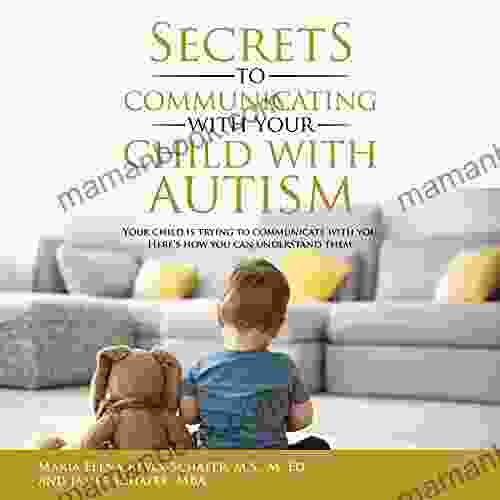Your Child Is Trying To Communicate With You: Here's How You Can Understand Them

As parents, we often yearn to understand our children's thoughts and feelings fully. While toddlers may not be able to express themselves verbally, they possess a unique ability to communicate through their actions, gestures, and expressions. It's our responsibility as caregivers to decipher these subtle cues and foster open and effective communication with our little ones.
4.6 out of 5
| Language | : | English |
| File size | : | 1930 KB |
| Text-to-Speech | : | Enabled |
| Screen Reader | : | Supported |
| Enhanced typesetting | : | Enabled |
| Word Wise | : | Enabled |
| Print length | : | 96 pages |
| Lending | : | Enabled |
Observing Nonverbal Cues
Children communicate a vast array of emotions and messages through their nonverbal behaviors. Keenly observing these cues can help us gain insights into their inner world. Here are some key nonverbal cues to watch for:
- Facial expressions: Smiles, frowns, grimaces, and other facial expressions convey a wide range of emotions.
- Body language: Crossed arms, fidgeting, or leaning in can indicate discomfort, boredom, or interest.
- Eye contact: Prolonged eye contact can signal engagement and trust, while avoiding eye contact may suggest shyness or discomfort.
- Gestures: Pointing, waving, or clapping are early forms of communication that convey specific messages.
- Posture: Slumped shoulders may indicate sadness or tiredness, while an upright posture often portrays confidence.
Decoding Your Child's Vocalizations
Vocalizations, such as babbling, crying, and cooing, are also crucial forms of communication for young children. Understanding the different types of vocalizations and their potential meanings can help us interpret our children's needs and intentions.
- Babbling: Repetitive, non-word sounds that usually occur between 6-12 months indicate language development.
- Crying: Crying is a universal expression of distress and can signal hunger, discomfort, or pain.
- Cooing: Soft, gentle sounds that often accompany smiles and eye contact express contentment.
- Exclamatory sounds: Sudden, high-pitched sounds may indicate surprise, excitement, or frustration.
- Intentional sounds: Specific sounds, such as "mama" or "baba," are often the first attempts at meaningful speech.
Understanding Your Child's Developmental Stage
A child's developmental stage significantly influences their communication abilities. Here are some general milestones to keep in mind:
- 0-6 months: Nonverbal cues, such as crying, cooing, and facial expressions, are the primary means of communication.
- 6-12 months: Babbling becomes more frequent and complex, and gestures are used intentionally.
- 12-18 months: First words emerge, and toddlers begin to combine words into simple phrases.
- 18-24 months: Vocabulary expands rapidly, and toddlers start using more complex sentences.
- 2-3 years: Speech becomes more fluent, and toddlers use pronouns and prepositions correctly.
Fostering Open Communication
To encourage open and effective communication with your child, it's essential to create a supportive and receptive environment:
- Active listening: Pay attention to your child's vocalizations, gestures, and expressions without interrupting.
- Verbalizing emotions: Help your child label and express their emotions by describing their feelings accurately.
- Encouraging questions: Ask open-ended questions to invite your child to share their thoughts and experiences.
- Using gestures and facial expressions: Enhance your child's understanding by using gestures, facial expressions, and body language to complement your words.
- Reading and storytelling: Reading to your child and engaging in storytelling helps expand their vocabulary and language skills.
Challenges and Concerns
While most children develop speech and language skills naturally, some may face challenges or delays. If you notice any of the following concerns, it's essential to seek professional evaluation:
- Delayed language development (not meeting language milestones)
- Difficulty understanding or following simple instructions
- Limited vocabulary or difficulty expressing thoughts
- Stuttering or speech impediments
- Social or behavioral difficulties related to communication
Understanding our children's communication goes beyond words. By observing nonverbal cues, deciphering vocalizations, considering their developmental stage, and fostering open communication, we can create a bridge of understanding that strengthens the parent-child bond. Remember, every child is unique, and their journey of communication is as individual as they are. By approaching each conversation with patience, love, and an open heart, we can empower our little ones to express themselves fully and ensure their voices are heard.
4.6 out of 5
| Language | : | English |
| File size | : | 1930 KB |
| Text-to-Speech | : | Enabled |
| Screen Reader | : | Supported |
| Enhanced typesetting | : | Enabled |
| Word Wise | : | Enabled |
| Print length | : | 96 pages |
| Lending | : | Enabled |
Do you want to contribute by writing guest posts on this blog?
Please contact us and send us a resume of previous articles that you have written.
 Top Book
Top Book Novel
Novel Fiction
Fiction Nonfiction
Nonfiction Literature
Literature Paperback
Paperback Hardcover
Hardcover E-book
E-book Audiobook
Audiobook Bestseller
Bestseller Classic
Classic Mystery
Mystery Thriller
Thriller Romance
Romance Fantasy
Fantasy Science Fiction
Science Fiction Biography
Biography Memoir
Memoir Autobiography
Autobiography Poetry
Poetry Drama
Drama Historical Fiction
Historical Fiction Self-help
Self-help Young Adult
Young Adult Childrens Books
Childrens Books Graphic Novel
Graphic Novel Anthology
Anthology Series
Series Encyclopedia
Encyclopedia Reference
Reference Guidebook
Guidebook Textbook
Textbook Workbook
Workbook Journal
Journal Diary
Diary Manuscript
Manuscript Folio
Folio Pulp Fiction
Pulp Fiction Short Stories
Short Stories Fairy Tales
Fairy Tales Fables
Fables Mythology
Mythology Philosophy
Philosophy Religion
Religion Spirituality
Spirituality Essays
Essays Critique
Critique Commentary
Commentary Glossary
Glossary Bibliography
Bibliography Index
Index Table of Contents
Table of Contents Preface
Preface Introduction
Introduction Foreword
Foreword Afterword
Afterword Appendices
Appendices Annotations
Annotations Footnotes
Footnotes Epilogue
Epilogue Prologue
Prologue Stephen C Kucko
Stephen C Kucko Stanley Meisler
Stanley Meisler London Miller
London Miller Sheila Lamb
Sheila Lamb Dean King
Dean King Kelvin Teo
Kelvin Teo Henry E Prante
Henry E Prante Donna M Brinton
Donna M Brinton Frank Tieri
Frank Tieri Samantha Belanger
Samantha Belanger Edwin Felix
Edwin Felix Pleasant Surprise
Pleasant Surprise Vincent Bevins
Vincent Bevins Zach Sears
Zach Sears Neville Goddard
Neville Goddard Samantha Wells
Samantha Wells Deborah Parker
Deborah Parker Tyrone L Waller
Tyrone L Waller Steven Heighton
Steven Heighton Randy Rainbow
Randy Rainbow

 Ernest Powell
Ernest PowellBenefits of Corporal Punishment: A Review of the...
Corporal punishment is a form of physical...

 Bobby Howard
Bobby HowardThe Development and Significance of African American...
African American...

 Guy Powell
Guy PowellDown Girl: The Logic of Misogyny - A Comprehensive...
In her groundbreaking work,...

 Forrest Blair
Forrest BlairThe Bikini Changing Room: A Micro Mini Romance
In the heart of...
4.6 out of 5
| Language | : | English |
| File size | : | 1930 KB |
| Text-to-Speech | : | Enabled |
| Screen Reader | : | Supported |
| Enhanced typesetting | : | Enabled |
| Word Wise | : | Enabled |
| Print length | : | 96 pages |
| Lending | : | Enabled |
























